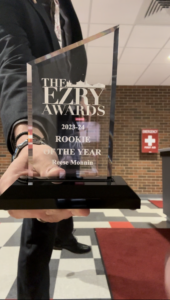I have a hypothesis that, in Scotland, every historic monument is on top of a giant hill. Stirling’s Wallace Monument is no different.
 From the university and most of the surrounding town, the tower is prominent in the skyline. It can serve as a makeshift waypoint if you’re desperate. Even at night, the top is lit up then.
From the university and most of the surrounding town, the tower is prominent in the skyline. It can serve as a makeshift waypoint if you’re desperate. Even at night, the top is lit up then.
The monument was built in 1869 in honor of the thirteenth-century Scottish hero William Wallace. He might be most familiar from the horribly inaccurate film “Braveheart.” The tower is built on the peak of Abbey Craig, where it is said that Wallace watched for the English in the events leading up to the Battle of Stirling Bridge. It’s not hard to imagine why: even before going up the 220 feet to the top of the monument, you can see for miles from just the base.
But you can go up the whole thing, up the 246 steps of a spiral staircase that, at its widest, the structure could barely fit the entirety of a women’s size nine shoe.
The trek upwards is divided into sections on the history of a variety of things.
On one floor, there is a lecture on Scottish lines of inheritance and the impact of the Scottish Rebellion. There are plaques on the impact of military strategy that resulted from the Scottish winning the Battle of Stirling Bridge, since they were heavily outnumbered and were foot soldiers facing cavalry. Through routing the English across the bridge and limiting their numbers and movement, they ambushed them to gain the element of surprise.
Another level is a number of busts of famous Scottish people, including people like King Robert the Bruce, Robert Burns and Sir Walter Scotts. In the center of the room is probably the most impressive piece: the Wallace Sword. In a glass case is a claymore taller than I am. A sign behind it marks it as 1.6 meters, or 5’4’’ and weighing in at 3 kg. Despite the name, it’s likely an old fake and never really belonged to Wallace. If it did, it would have only be used as a ceremonial sword, being as it would be impractical for combat.
At the top of the tower is probably the most spectacular view. On a clear day, you can see the vague outline of Edinburgh about 35 miles away. The surrounding town with its rivers and farms and sheep and coos (fluffy cows) are put on a brilliant display from this vantage point. It’s worth the slippery, muddy hill. It’s even worth the tiny stairs that are worse going down than up.







